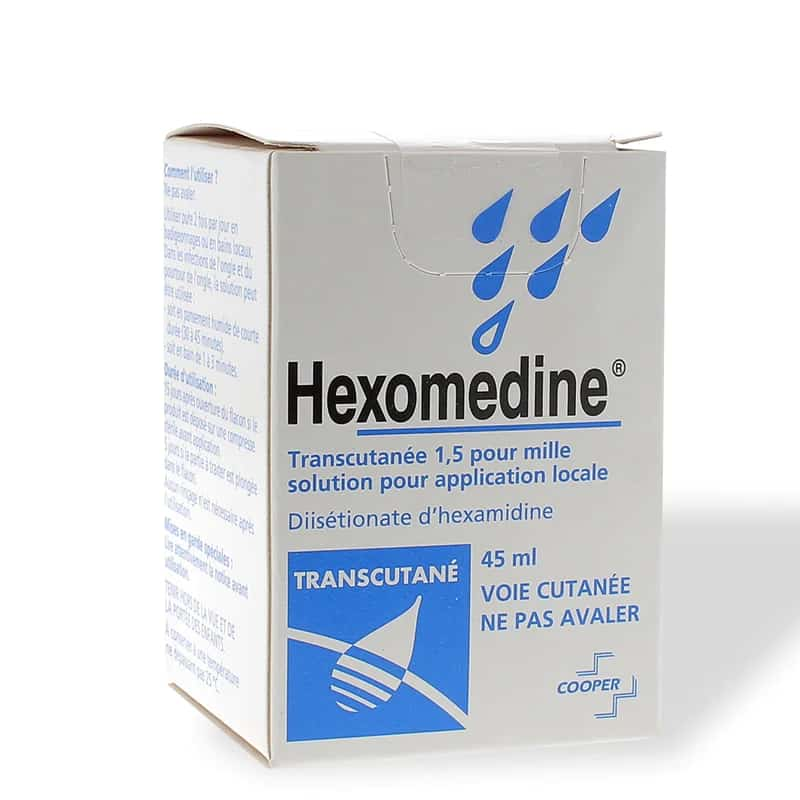Hexomedine Transcutaneous Topical Solution
Hexomedine is a disinfectant for external use. Hexomedine solution is used as an adjunctive treatment for skin infections (use on the skin) and infected or possibly infected mucous membranes.
Hexomedine Transdermal (through the skin) is also used as an additional treatment for localized skin infections, especially inflammation of hair follicles (folliculitis) and infected nails.
Hexomedine solution content:
- Active ingredient: Hexamidine diisethionate 1 mg/ml.
- Other ingredients are: isopropyl alcohol and purified water.
Hexomedine Transdermal:
- Active ingredient: Hexamidine diisethionate 1.5 mg/ml.
- Other ingredients include: 96% ethanol, propylene glycol, methylal, nonoxynol 9 and purified water.

How To Use Hexomedine?
Always use this medicine exactly as described in this leaflet or exactly as discussed with your doctor or pharmacist. If you are not sure, ask your doctor or pharmacist.
- Hexomedine solution: Hexomedin is used pure, undiluted, 2 to 3 times a day locally on a specific area or by applying a moist compress.
- Hexomedine Transdermal: Hexomedine Transdermal can be used 2 to 3 times a day in its pure, undiluted form. To use this product, you can apply a damp bandage for 30 to 45 minutes or dip your finger directly into the solution inside the product for 1 to 3 minutes. This solution is conveniently designed to moisturize an infected finger. However, it should not be used on open wounds, mucous membranes, or under medical bandages used to prevent the wound from drying out.
Do not use Hexomedine for more than 5 days, especially if you are using Hexomedine under a dressing that prevents the wound from drying out, on damaged skin (e.g. burned skin), on mucous membranes, or on the skin of an infant.
If you use more Hexomedin than you should, contact your doctor, pharmacist or poison control center immediately. If the drug is accidentally ingested, administration of activated charcoal (a strong binding agent) and possibly gastric lavage is recommended. In case of respiratory depression, the patient should be hospitalized as soon as possible.
If you have additional questions regarding the use of this medication, consult your doctor or pharmacist.
Side Effects
Like all medicines, this medicine can cause side effects, but not everyone gets them.
It is possible that you may develop hypersensitivity to the drug. Therefore, do not use the product too much or for too long, or on skin that is already damaged or severely affected.
Hypersensitivity to the drug may manifest itself with a tingling sensation, itching, burns and dry skin. In exceptional cases, allergic skin reactions and even severe hypersensitivity reactions (anaphylactic reactions) are possible.
If you notice any side effects, contact your doctor or pharmacist. This also applies to side effects not listed in this leaflet.
Warnings
This medicine should not be used in the following cases:
- If you are allergic to diamine derivatives or any of the other ingredients of this medicine.
- It should not be used to disinfect skin or sterilize objects before an injection.
- Do not apply this product to mucous membranes or a baby’s skin unless directed by a doctor.
Please talk to your doctor or pharmacist before using Hexomedine.
Do not use this medicine for more than 5 days, especially if:
- under a bandage that prevents the wound from drying out (occlusive bandage)
- on damaged skin (e.g. burned skin)
- Avoid contact with eyes.
- Do not apply Hexomedine Transdermal to open wounds.
If you are using, have recently used, or might use any other medications, tell your doctor or pharmacist.
There is no point in using other antiseptics at the same time or afterwards.
If you are pregnant or breast-feeding, think you may be pregnant, or are planning to have a baby, consult your doctor or pharmacist before using this medicine.
To date, no negative consequences of its use during pregnancy and breastfeeding are known.
Hexomedine Transdermal contains propylene glycol. This may cause skin irritation.
Our other article, animax ointment, may also attract your attention.
